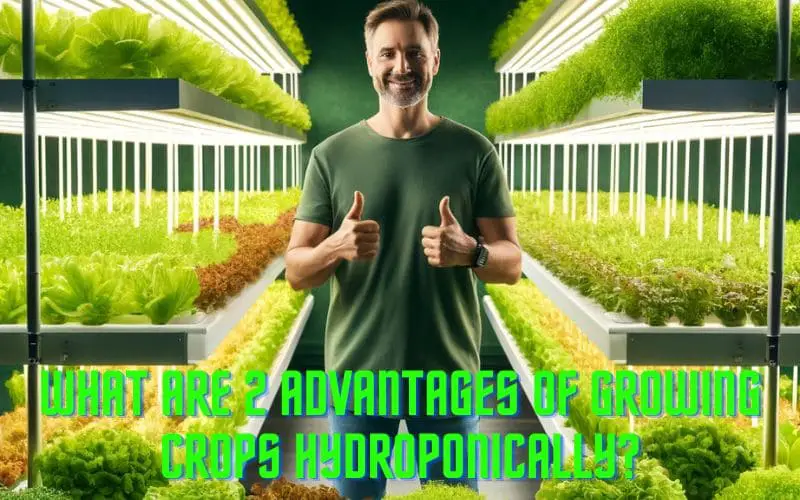What Are 2 Advantages Of Growing Crops Hydroponically?

Introduction
Welcome to our engaging and easy-to-understand guide on soilless agriculture, focusing on the innovative world of hydroponic farming. In this exploration, we’ll dive into the numerous benefits of growing crops hydroponically. Discover how this method not only allows for cultivating plants in limited spaces but also promotes sustainable practices. We’ll highlight two key advantages of hydroponics and explain how these techniques are transforming the way we think about farming and plant growth. Join us as we navigate through the cutting-edge realm of agriculture without soil.
Answer to the Question
Hydroponic farming, where crops are grown in a water-based, nutrient-rich solution without soil, offers several distinct advantages. One major benefit is the significant increase in water efficiency. In traditional agriculture, much of the water used for irrigation is lost due to soil absorption and evaporation, but hydroponic systems recycle the water, drastically reducing overall consumption. This method is especially beneficial in areas where water is scarce. Additionally, hydroponics allows for precise control over nutrient delivery to the plants, promoting optimal growth and potentially higher yields compared to soil-based farming.
Another advantage of hydroponic farming is the ability to grow crops in non-traditional settings, such as urban environments or regions with poor soil quality. Since the system does not require soil, it can be set up in places where traditional agriculture might be unfeasible, like rooftops, abandoned warehouses, or in regions with harsh climates. This versatility also means that food can be grown closer to urban centers, reducing transportation costs and carbon emissions, while ensuring fresher produce reaches consumers more quickly.
Advantage 1: Resource Efficiency
Reduced Water Usage
Hydroponics is a highly resource-efficient method of growing plants that offers several advantages over traditional soil-based agriculture. In hydroponic systems, plants are grown in a water-based solution enriched with essential nutrients, eliminating the need for soil. This method dramatically reduces water usage, as the closed systems allow for water to be recycled and reused, cutting down water consumption by as much as 90% compared to conventional farming. Additionally, hydroponics can be implemented in controlled environments, which minimizes the loss of nutrients to the environment and enhances nutrient uptake efficiency in plants.
Saving Space
Another key aspect of hydroponics is its spatial efficiency. Since the system doesn’t rely on vast tracts of arable land, it can be set up in urban environments such as rooftops or abandoned warehouses, significantly reducing the need for space and the transportation costs and emissions associated with traditional farming. The controlled environment also means that plants are less susceptible to pests and diseases, reducing the need for chemical pesticides and fertilizers. This not only makes hydroponics more environmentally friendly but also helps in producing cleaner, more organic produce.
Advantage 2: Controlled Environment
Optimized Nutrient Delivery
Hydroponic farming enables precise control over nutrient delivery to plants, ensuring that they receive the ideal balance of essential nutrients for vigorous growth and enhanced nutritional value. This optimized nutrient delivery results in healthier crops and superior quality produce, meeting the demand for nutritious food in a controlled environment.
- Hydroponic farming allows for custom nutrient solutions to be tailored specifically to the needs of different plants, optimizing their growth and health.
- By delivering nutrients directly to the roots, hydroponic systems bypass the soil, allowing for faster and more efficient uptake of nutrients by plants.
- The controlled environment of hydroponic farming enables the adjustment of nutrient levels based on plant growth stage and environmental conditions, ensuring optimal nutrient delivery at all times.
Pest and Disease Management
Pest and Disease Management
- Integrated Pest Management (IPM): Hydroponic farming allows for the implementation of IPM. This is a sustainable approach to managing pests and diseases. Through the use of natural predators, traps, and biological controls, hydroponic systems reduce the need for chemical pesticides. As a result, the impact on the environment is minimized.
- Pathogen Control: In hydroponic farming, the absence of soil eliminates the risk of soil-borne diseases. Examples of such diseases include Fusarium wilt and root rot. This not only prevents crop damage but also ensures a healthier growing environment for plants. This will reduce the reliance on fungicides and other disease management chemicals.
- Beneficial Microorganisms: The controlled environment of hydroponic systems allows for the introduction of beneficial microorganisms, such as mycorrhizal fungi and rhizobacteria. These form symbiotic relationships with plant roots. These beneficial microbes enhance plant defense mechanisms, improve nutrient uptake, and suppress harmful pathogens, contributing to overall disease resistance.
Conclusion
As we wrap up our discussion on hydroponic farming, it’s clear that this method of growing crops offers significant benefits for sustainable agriculture. Hydroponic systems use water and nutrients more efficiently and provide a controlled environment that helps manage pests and diseases effectively. These features make hydroponic farming a promising solution for producing food in an environmentally friendly way while meeting nutritional needs.
